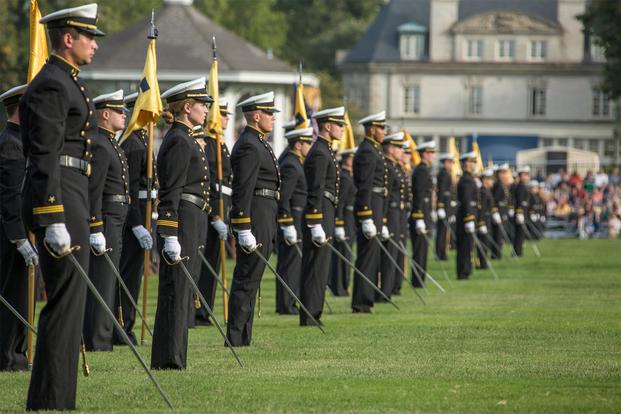The authors have a total of nearly three decades of military experience spanning a Marine Corps Recruit Depot, the United States Naval Academy and the Fleet Forces.
Historically, marching in formation was a method to move military units in an orderly and efficient manner, from point A to point B, in preparation for battle. As warfare developed, marching in mass formation became an ineffective method of fighting.
Nevertheless, parades have remained a long-standing tradition for military members of all services.
Recently, an argument was made to get rid of parades at the United States Naval Academy. Midshipman Second Class Ezra Haddock wrote, "A parade is nothing more than an exercise in mindlessness and blind obedience that takes away time from more productive endeavors such as homework or physical fitness."
The assumption made by many midshipmen is that Naval Academy parades are done either for tradition or to impress a high-ranking officer or dignitary coming back for their class reunion at that weekend's football game.
Related: Want to Bring the Naval Academy into the 21st Century? Get Rid of Parades
While tradition is an ever-important aspect in our profession, and marching for military officers with stars on their collars is a nice sentiment, parades at the service academies serve a much greater purpose.
At its core, the Naval Academy is a leadership laboratory. There is an entire cadre of drill staff, which includes both active-duty academy staff and midshipmen, dedicated to leading parades and ceremonies. Frankly, these midshipmen are required to inspire their peers and underclassmen to participate fully in something they may not necessarily want to do.
Sound familiar? Anyone who has ever held a leadership role in a division on a ship, a platoon, a shop or a squadron knows that this situation occurs on a daily basis. Subsequently, this affords another opportunity for small-unit leadership that will undoubtedly be extremely similar to a newly commissioned officer's first day leading sailors or Marines.
For the midshipmen who are atop the drill chain of command (i.e. the Midshipmen Brigade Drill Officers), parades are an exercise in large organizational operations. While the Midshipmen Company Drill Officers are focused on getting the individual midshipmen within their company to stay in step, the Brigade Drill Officer is dedicated to ensuring the entire brigade of 4,400 midshipmen steps off on time and accomplishes the mission.
The Naval Academy's mission statement discusses a dedication to lifelong service in government. As careers progress, be it in the military or in the private sector, graduates often find themselves leading and organizing large, integrated groups of people. These examples can span from planning exercises in the Pacific Ocean (i.e. RIMPAC) to representing an entire congressional district in Congress. Although Naval Academy parades are not on such a scale, the process by which planning and organization are done is incredibly analogous.
Obviously, not all midshipmen are in a leadership role. Yet, during the parade, as the cannons sound, the drums beat, and the band plays Anchors Aweigh and the Marines' Hymn, there is a widespread sense of esprit de corps. Everyone from the spectators in the stands to the Plebes standing in the back of the formation can't help but be proud of being part of that moment.
While we're on the topic of morale, we must also recognize the fact that these parades are graded by the drill staff, both midshipmen and academy military staff. The parade results are sent out to the entire school, publicizing which companies performed at the highest level, and which … were standard at best.
Not only does competition breed excellence, it also brings togetherness. With regard to drill, it's simply a matter of pride and selflessness. Yes, it is just marching, just standing, and just some movements of the rifle. But to move 150 people (the size of a company) as one body requires that every single person execute their role. To win battles against our adversaries, everybody, from the seaman to the admiral, needs to perfect their job. The detail and focus it takes for a 90-minute parade is much less than that on the seventh month of a deployment. But unlike a deployment, lives are not at stake on Worden Field.
While parades may seem like a waste of time to the average second-class midshipman half-heartedly attempting to stay aligned to the right, the parade serves as an opportunity for unity, pride, development and mental toughness. As the bead of sweat drips down that midshipman's face, does he break military bearing and wipe himself? As the gnat bounces off the nose of the Firstie standing out in front of the Brigade, does she swivel her head to avoid the bug?
As a compromise, we offer a plan to cut back parades to three per year:
- To welcome back and reform the Brigade of Midshipmen at the beginning of the year;
- A "Link in the Chain Recognition" (which consists of alumni 50 years prior to the current year's graduation class) on a Friday during home football weekend;
- The "Color Parade" to close out the academic year and send off the graduating class.
Doing so would mean the leadership opportunities would still exist for those who take charge, and the benefits of participating in the parade would be easily attained.
-- The opinions expressed in this op-ed are those of the author and do not necessarily reflect the views of Military.com. If you would like to submit your own commentary, please send your article to opinions@military.com for consideration.















